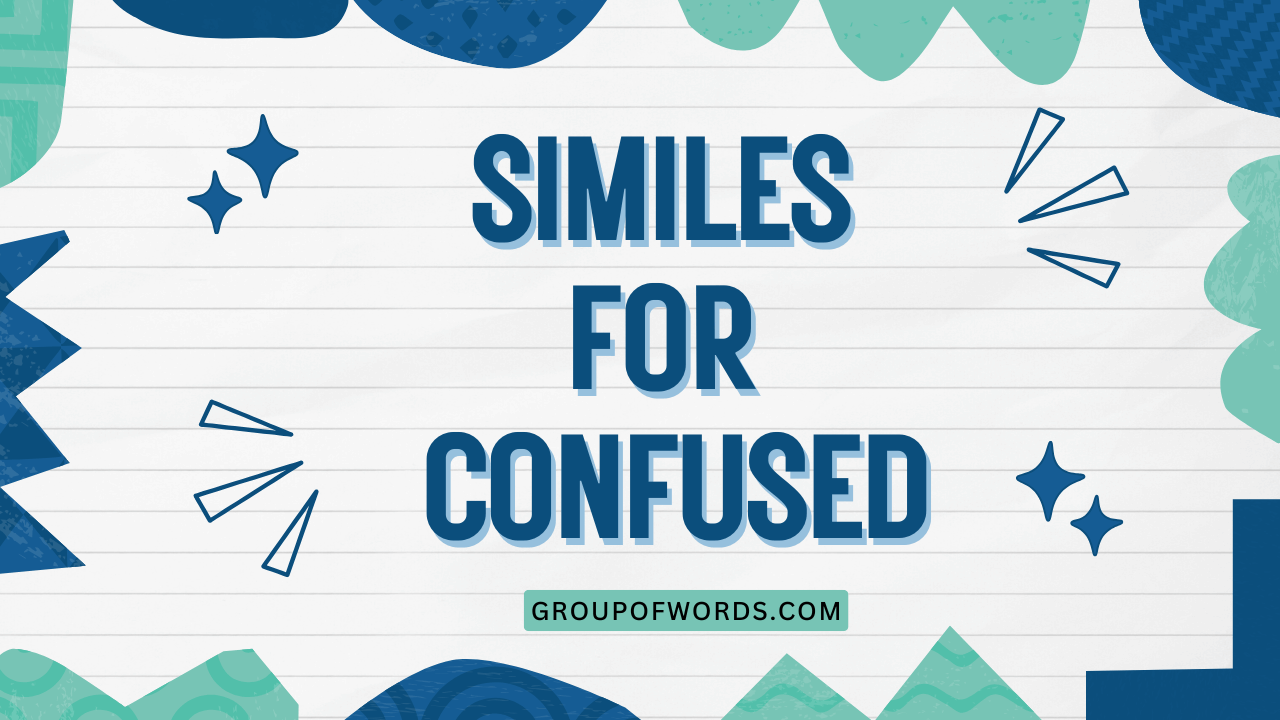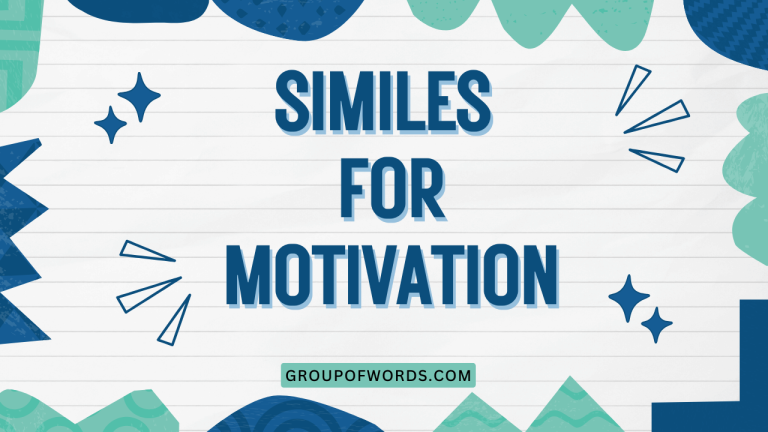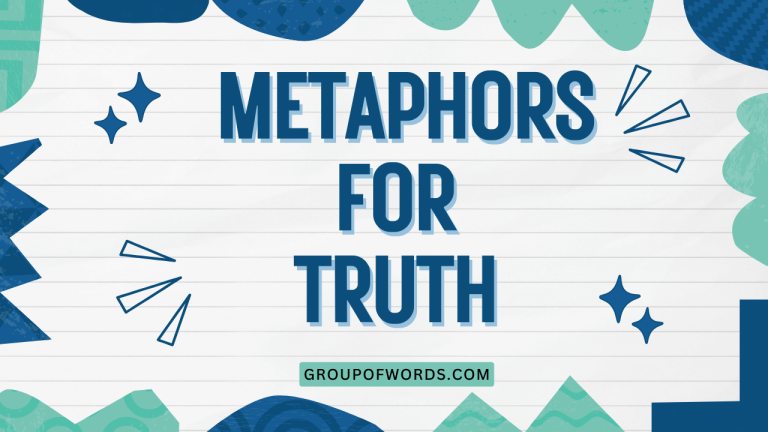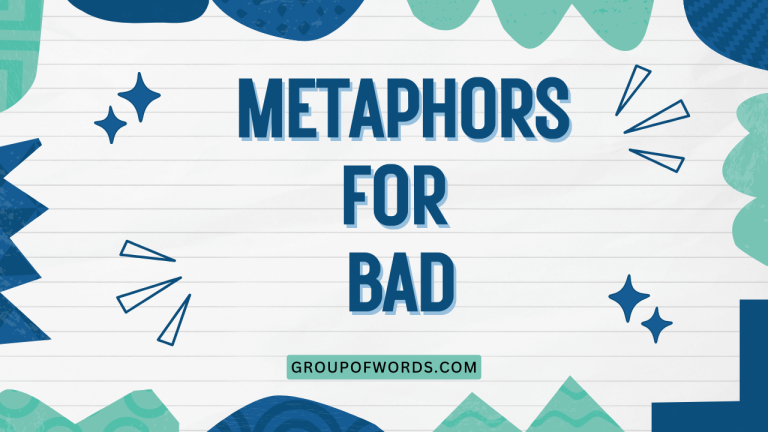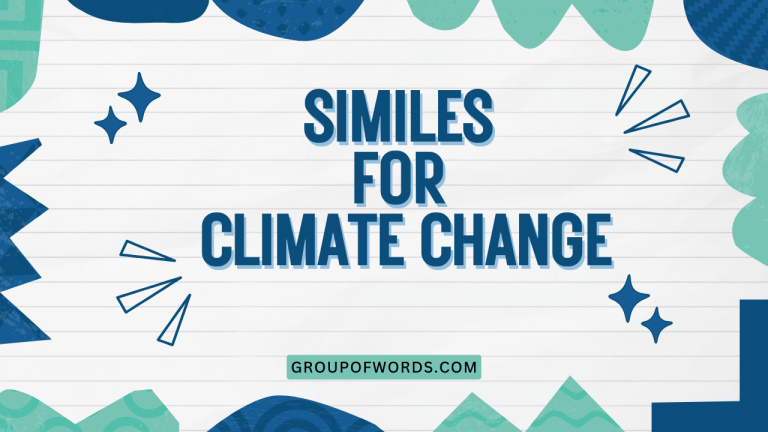Lost in the Woods: Mastering Similes for Confusion
Understanding how to effectively describe confusion is crucial for clear and engaging communication. Similes, with their ability to draw comparisons, offer a powerful tool for conveying the nuanced feeling of being bewildered.
This article delves into the world of similes used to express confusion, exploring their structure, usage, and impact. Whether you’re a student aiming to enhance your writing skills, a professional seeking to improve your communication, or simply a language enthusiast, this guide will equip you with the knowledge to use similes for confusion with confidence and precision.
By mastering these similes, you can paint vivid pictures of mental disarray, helping your audience truly understand the state of confusion you’re describing. This article will cover various types of similes, provide numerous examples, and offer practical exercises to solidify your understanding.
Let’s embark on this journey to unlock the expressive potential of similes in portraying confusion.
Table of Contents
- Definition of Similes for Confusion
- Structural Breakdown of Similes for Confusion
- Types of Similes for Confusion
- Examples of Similes for Confusion
- Usage Rules for Similes of Confusion
- Common Mistakes When Using Similes for Confusion
- Practice Exercises
- Advanced Topics
- Frequently Asked Questions
- Conclusion
Definition of Similes for Confusion
A simile is a figure of speech that directly compares two different things using the words “like” or “as.” Similes are used to make descriptions more vivid and relatable by drawing parallels between the unfamiliar and the familiar. In the context of describing confusion, similes help to convey the feeling of being disoriented, perplexed, or bewildered by comparing it to something else that embodies these qualities.
The key is to find a comparison that resonates with the audience and effectively communicates the specific nuance of confusion you’re trying to portray.
The function of a simile for confusion is to create a mental image or feeling in the reader or listener, allowing them to better understand the internal state of the confused person. This is achieved by linking the abstract feeling of confusion to something concrete and understandable.
For example, saying someone is “as lost as a sheep in the woods” paints a clear picture of someone completely disoriented and uncertain.
Similes can be used in various contexts, from literature and poetry to everyday conversation and professional communication. They are particularly effective in situations where you want to emphasize the intensity or specific nature of the confusion.
Understanding the power of similes allows you to enrich your language and communicate more effectively.
Structural Breakdown of Similes for Confusion
The basic structure of a simile for confusion, like any simile, consists of three key elements:
- The Subject: This is the person or thing experiencing confusion.
- The Connecting Word: This is either “like” or “as.”
- The Comparison: This is the object, situation, or concept to which the subject’s confusion is being compared.
The formula can be represented as: Subject + Connecting Word + Comparison. For example, in the simile “He was as confused as a newborn kitten,” “He” is the subject, “as” is the connecting word, and “a newborn kitten” is the comparison.
The effectiveness of a simile depends on the strength and relevance of the comparison. A good simile should create a clear and immediate connection in the mind of the audience.
The comparison should be something that is easily understood and evokes the desired feeling of confusion.
Consider the following examples to illustrate the structural breakdown:
- She felt like a fish out of water. (She = Subject, like = Connecting Word, a fish out of water = Comparison)
- The instructions were as clear as mud. (The instructions = Subject, as = Connecting Word, clear as mud = Comparison)
- He looked like he’d seen a ghost. (He = Subject, like = Connecting Word, he’d seen a ghost = Comparison)
Understanding this structure is essential for creating effective similes and for analyzing the similes used by others. By mastering the structure, you can craft similes that are both accurate and evocative, enhancing your ability to communicate the feeling of confusion.
Types of Similes for Confusion
Similes for confusion can be categorized based on the type of comparison they make. Here are some common types:
Similes Comparing Confusion to Physical Disorientation
These similes use physical states of being lost or disoriented to describe mental confusion. They often involve imagery of being lost in a physical space or struggling to navigate one’s surroundings.
Similes Comparing Confusion to Lack of Understanding
These similes focus on the inability to comprehend something, often comparing the situation to being unable to decipher a code or understand a foreign language.
Similes Comparing Confusion to Emotional Turmoil
These similes link confusion to feelings of being overwhelmed, frustrated, or anxious. They often involve comparisons to chaotic or unsettling situations.
Similes Comparing Confusion to Sensory Overload
These similes draw parallels between confusion and the experience of being bombarded with too much sensory information, such as loud noises or flashing lights.
Similes Comparing Confusion to Cognitive Impairment
These similes relate confusion to states of mental impairment, such as being drunk, sleepy, or mentally ill (using respectful and appropriate language).
By understanding these different types of similes, you can choose the most appropriate comparison to accurately convey the specific nuance of confusion you’re trying to describe. Each type offers a unique perspective and can be used to create a more vivid and impactful image in the mind of the audience.
Examples of Similes for Confusion
Here are numerous examples of similes for confusion, organized by the categories discussed above. Each example is designed to illustrate the different ways in which similes can be used to describe the feeling of being confused.
Examples of Similes Comparing Confusion to Physical Disorientation
These examples illustrate how physical disorientation can be used to describe mental confusion. The comparison is often to being lost in a physical space or struggling to find one’s way.
| Simile | Explanation |
|---|---|
| He was as lost as a sheep in the woods. | Completely disoriented and unable to find his way. |
| She felt like a ship without a rudder. | Lacking direction and control. |
| I’m as turned around as a compass in a magnetic field. | Completely bewildered and unable to find my bearings. |
| He wandered through the argument like a blind man in a maze. | Unable to understand or navigate the complexities of the situation. |
| Her mind was like a tangled ball of yarn. | Confused and disorganized thoughts. |
| The city felt like a labyrinth to him. | Overwhelmed and disoriented by the complexity of the city. |
| He was as disoriented as someone waking up from anesthesia. | Feeling groggy and uncertain. |
| She felt like she was walking through a fog. | Unable to see clearly or think straight. |
| His thoughts were scattered like leaves in the wind. | Disorganized and difficult to follow. |
| The situation was as clear as a dense fog. | Obscure and difficult to understand. |
| He felt like he was drowning in information. | Overwhelmed by the amount of information. |
| She was as bewildered as a tourist in a foreign country. | Confused and unfamiliar with the surroundings. |
| His understanding of the topic was as shaky as a house of cards. | Unstable and likely to collapse. |
| The explanation left him feeling like he was chasing his own tail. | Going in circles and making no progress. |
| She felt like she was trapped in a never-ending loop. | Repeating the same mistakes or thoughts. |
| He was as out of place as a penguin in the desert. | Feeling uncomfortable and lost. |
| She felt like she was navigating through a minefield. | Approaching a situation with caution and uncertainty. |
| His thoughts were as jumbled as a mixed-up puzzle. | Disorganized and difficult to piece together. |
| The instructions were as clear as a Jackson Pollock painting. | Abstract and difficult to interpret. |
| He felt like he was wandering in a dream. | Disoriented and detached from reality. |
| She felt like she was lost in a sea of faces. | Overwhelmed and unable to focus. |
| His understanding was as fragmented as a shattered mirror. | Incomplete and distorted. |
| The explanation was as convoluted as a Rube Goldberg machine. | Overly complicated and difficult to follow. |
| He felt like he was swimming against the current. | Struggling to understand or make progress. |
| She felt as though she was walking on eggshells. | Anxious and uncertain about her next step. |
Examples of Similes Comparing Confusion to Lack of Understanding
These examples highlight the inability to comprehend something, comparing the situation to being unable to decipher a code or understand a foreign language.
| Simile | Explanation |
|---|---|
| It’s all Greek to me. | Completely incomprehensible. |
| The instructions were as clear as mud. | Difficult to understand and follow. |
| I felt like I was trying to read hieroglyphics. | Unable to decipher the meaning. |
| The explanation was as clear as a foreign language. | Unintelligible and confusing. |
| He looked at the equation like it was written in Martian. | Completely puzzled and unable to understand. |
| The concept was as foreign to her as quantum physics. | Completely unfamiliar and difficult to grasp. |
| Understanding the theorem was like trying to solve a riddle in the dark. | Challenging and obscure. |
| The directions were as helpful as a map of the moon. | Useless and irrelevant. |
| Trying to understand his explanation was like decoding a secret message. | Complex and requiring effort to decipher. |
| The problem was as unsolvable as a Rubik’s Cube in the dark. | Extremely difficult or impossible to solve. |
| He looked at the contract like it was written in code. | Confused and unable to understand the legal terminology. |
| The teacher’s explanation was as clear as alphabet soup. | Disorganized and difficult to make sense of. |
| Understanding the new software was like learning a completely new language. | Challenging and requiring significant effort. |
| The instructions were as straightforward as a plate of spaghetti. | Complicated and tangled. |
| Trying to follow his logic was like navigating a maze blindfolded. | Difficult and confusing. |
| The lecture was as engaging as watching paint dry. | Boring and difficult to focus on. |
| Understanding the plot was like trying to piece together a shredded document. | Fragmented and difficult to reconstruct. |
| The rules were as consistent as the weather. | Unpredictable and unreliable. |
| Trying to explain the concept was like herding cats. | Difficult and frustrating. |
| The situation was as clear as a crystal ball. | Obscure and uncertain. |
| The problem was as intricate as a spider’s web. | Complex and delicate. |
| The explanation was as enlightening as a black hole. | Uninformative and obscure. |
| Trying to understand his reasoning was like trying to catch smoke. | Elusive and impossible to grasp. |
| The situation was as transparent as a brick wall. | Opaque and unrevealing. |
| The instructions were as simple as quantum physics. | Complex and difficult to understand. |
Examples of Similes Comparing Confusion to Emotional Turmoil
These examples link confusion to feelings of being overwhelmed, frustrated, or anxious, often comparing the situation to chaotic or unsettling events.
| Simile | Explanation |
|---|---|
| He felt like his brain was in a blender. | Thoughts jumbled and disorganized. |
| She was as flustered as a chicken with its head cut off. | Agitated and disoriented. |
| I felt like I was drowning in a sea of uncertainty. | Overwhelmed by doubt and confusion. |
| Her mind was racing like a runaway train. | Thoughts uncontrollable and frantic. |
| He felt like he was trapped in a whirlwind of emotions. | Overwhelmed by intense and conflicting feelings. |
| She was as rattled as a snake in a tin can. | Nervous and agitated. |
| His thoughts were as chaotic as a battlefield. | Disorganized and conflicting. |
| She felt like she was walking on thin ice. | Anxious and uncertain. |
| He was as jumpy as a cat on a hot tin roof. | Extremely nervous and on edge. |
| Her mind was a tangled mess of anxieties. | Overwhelmed by worries and fears. |
| He felt like he was lost in a storm of emotions. | Overwhelmed by intense and conflicting feelings. |
| She was as bewildered as a deer in headlights. | Startled and disoriented. |
| His thoughts were as scattered as a broken mirror. | Fragmented and disorganized. |
| She felt like she was trapped in a nightmare. | Terrified and disoriented. |
| He was as discombobulated as a clown in a library. | Out of place and confused. |
| Her mind was as turbulent as a stormy sea. | Unsettled and chaotic. |
| He felt like he was juggling too many balls at once. | Overwhelmed and unable to focus. |
| She was as perplexed as a squirrel trying to bury a nut on concrete. | Frustrated and unable to understand. |
| His thoughts were as tangled as a fishing line. | Confused and difficult to untangle. |
| She felt like she was trapped in a maze of her own making. | Confused and unable to find a way out. |
| He was as puzzled as a baby trying to assemble IKEA furniture. | Confused and overwhelmed by the task. |
| She felt like she was walking through quicksand. | Struggling and sinking under the weight of confusion. |
| His mind was as foggy as a San Francisco morning. | Unclear and difficult to think straight. |
| She was as lost as a sock in the dryer. | Confused and unable to find her way. |
| He felt like he was trying to solve a riddle wrapped in an enigma. | Confused and unable to understand the problem. |
Usage Rules for Similes of Confusion
Using similes effectively requires understanding some basic rules. Here are some key guidelines to follow when crafting similes for confusion:
- Ensure the Comparison is Relevant: The object or situation you’re comparing confusion to should have a clear connection to the feeling of being confused. A random or unrelated comparison will only confuse your audience further.
- Use Clear and Familiar Comparisons: The comparison should be something that your audience is likely to understand. Avoid obscure references or overly complex analogies.
- Maintain Consistency: The simile should align with the overall tone and style of your writing. Avoid using overly informal or humorous similes in a serious context, and vice versa.
- Avoid Clichés: Overused similes can sound stale and unoriginal. Try to come up with fresh and creative comparisons that will capture your audience’s attention.
- Consider Your Audience: Tailor your similes to your audience’s background and knowledge. A simile that works for one audience may not be effective for another.
In addition to these general rules, it’s important to consider the specific context in which you’re using the simile. Are you trying to convey a mild sense of confusion, or a more intense feeling of bewilderment?
Choose your comparison accordingly.
Also, be mindful of the potential for misinterpretation. Make sure that your simile is clear and unambiguous, and that it accurately reflects the feeling of confusion you’re trying to describe.
Common Mistakes When Using Similes for Confusion
Even experienced writers can make mistakes when using similes. Here are some common errors to avoid:
- Using Ineffective Comparisons: Choosing a comparison that doesn’t effectively convey the feeling of confusion.
- Using Clichéd Similes: Relying on overused similes that lack originality and impact.
- Creating Confusing Similes: Using comparisons that are too complex or obscure, leading to further confusion.
- Mismatched Tone: Using similes that don’t align with the overall tone of the writing.
- Overusing Similes: Using too many similes in a single passage, which can become distracting and overwhelming.
Here are some examples of common mistakes, along with corrections:
| Incorrect | Correct | Explanation |
|---|---|---|
| He was as confused as a doorknob. | He was as confused as a student in advanced calculus. | The comparison to a doorknob is not relevant to confusion. |
| She was as confused as a bat. | She was as confused as a bat trying to navigate during the day. | “As confused as a bat” is a cliché and lacks specificity. |
| The instructions were as clear as the concept of quantum entanglement. | The instructions were as clear as mud. | The comparison to quantum entanglement is too complex and obscure. |
| He was as confused as a clown at a funeral. | He was as confused as a student who missed the lecture. | The simile is inappropriate for a serious context. |
By being aware of these common mistakes, you can avoid them and use similes more effectively to convey the feeling of confusion.
Practice Exercises
Test your understanding of similes for confusion with these practice exercises. For each question, choose the best simile to complete the sentence, or create your own.
| Question | Answer |
|---|---|
| 1. After the accident, he was __________. | as disoriented as someone waking up from anesthesia |
| 2. The instructions were __________. | as clear as mud |
| 3. Trying to understand the lecture was __________. | like trying to decode a secret message |
| 4. She felt __________ when she realized she was lost. | like a ship without a rudder |
| 5. He was __________ when he heard the news. | as bewildered as a deer in headlights |
| 6. The situation was __________. | as convoluted as a Rube Goldberg machine |
| 7. Her mind was __________. | like a tangled ball of yarn |
| 8. He looked at the equation __________. | like it was written in Martian |
| 9. Trying to explain the concept was __________. | like herding cats |
| 10. She felt __________ in the crowded room. | like she was lost in a sea of faces |
More Practice Exercises:
| Question | Answer |
|---|---|
| 11. After the change in plans, he was __________. | as lost as a tourist without a map |
| 12. The new policy was __________. | as clear as alphabet soup |
| 13. Trying to follow the argument was __________. | like navigating a maze blindfolded |
| 14. She felt __________ when she tried to use the new software. | like she was learning a completely new language |
| 15. He was __________ when he saw the magic trick. | as puzzled as a child with a broken toy |
| 16. The plot of the movie was __________. | as intricate as a spider’s web |
| 17. Her thoughts were __________. | scattered like leaves in the wind |
| 18. He looked at the legal document __________. | like it was written in code |
| 19. Trying to understand his reasoning was __________. | like trying to catch smoke |
| 20. She felt __________ during the presentation. | like she was drowning in information |
Even More Practice Exercises:
| Question | Answer |
|---|---|
| 21. After the unexpected turn of events, he was __________. | as bewildered as a penguin in the desert |
| 22. The speaker’s point was __________. | as enlightening as a black hole |
| 23. Trying to grasp the concept was __________. | like trying to solve a riddle wrapped in an enigma |
| 24. She felt __________ when she realized she forgot her keys. | like she was walking on eggshells |
| 25. He was __________ when he tried to assemble the furniture. | as frustrated as a squirrel trying to bury a nut on concrete |
| 26. The situation became __________. | as turbulent as a stormy sea |
| 27. Her mind was filled with __________. | a tangled mess of anxieties |
| 28. He looked at the advanced programming code __________. | like it was hieroglyphics |
| 29. Trying to follow the new regulations was __________. | like swimming against the current |
| 30. She felt __________ during the unexpected pop quiz. | like she was trapped in a nightmare |
Advanced Topics
For advanced learners, exploring the nuances of similes can lead to a deeper understanding of language and rhetoric. Here are some advanced topics to consider:
- Extended Similes: These are similes that are developed over several sentences or even paragraphs, creating a more elaborate comparison.
- Implied Similes: These are similes where the connecting word (“like” or “as”) is omitted, creating a more subtle comparison.
- The Role of Similes in Figurative Language: Understanding how similes contribute to the overall effect of figurative language, such as metaphors and personification.
- Cultural Variations in Similes: Exploring how different cultures use similes to express confusion, and how these variations reflect cultural values and beliefs.
- Creating Original and Effective Similes: Developing strategies for crafting similes that are both creative and impactful.
By delving into these advanced topics, you can refine your ability to use similes effectively and creatively, and gain a deeper appreciation for the power of language.
Frequently Asked Questions
Here are some frequently asked questions about similes for confusion:
- What is the difference between a simile and a metaphor?
A simile compares two things using “like” or “as,” while a metaphor directly states that one thing *is* another. For example, “He was as confused as a lost puppy” is a simile, while “He was a sea of confusion” is a metaphor.
- How do I choose the best simile for a particular situation?
Consider the specific nuance of confusion you want to convey, and choose a comparison that accurately reflects that feeling. Also, consider your audience and their background knowledge.
- Can I use similes in formal writing?
Yes, but use them sparingly and choose comparisons that are appropriate for the tone and style of your writing. Avoid overly informal or humorous similes in formal contexts.
- How can I avoid using clichéd similes?
Brainstorm fresh and original comparisons that haven’t been overused. Think about specific details and sensory experiences that can help you create a more vivid and unique image.
- Is it possible to overuse similes?
Yes, using too many similes in a single passage can become distracting and overwhelming. Use them judiciously and only when they add value to your writing.
- How do I create an implied simile?
An implied simile omits the words “like” or “as,” creating a more subtle comparison. For example, instead of saying “He was as lost as a sheep in the woods,” you could say “He wandered through the woods, a lost sheep.”
- How can cultural differences affect the understanding of similes?
Similes often rely on cultural references and shared experiences. A simile that is effective in one culture may not be understood or appreciated in another. Be mindful of your audience’s cultural background when using similes.
- What makes a simile effective?
An effective simile is relevant, clear, original, and appropriate for the context. It should create a vivid and memorable image in the mind of the audience and accurately convey the intended meaning.
Conclusion
Mastering similes for confusion is a valuable skill for anyone seeking to improve their communication. By understanding the structure, types, and usage rules of similes, you can effectively convey the nuanced feeling of being bewildered.
Remember to choose relevant and clear comparisons, avoid clichés, and consider your audience. Practice regularly, and be mindful of common mistakes.
Similes offer a powerful tool for enriching your language and creating vivid images in the minds of your readers or listeners. By incorporating them thoughtfully into your writing and speaking, you can enhance your ability to communicate effectively and engage your audience.
Keep exploring, experimenting, and refining your skills, and you’ll find that similes become an indispensable part of your linguistic toolkit. Happy writing!
